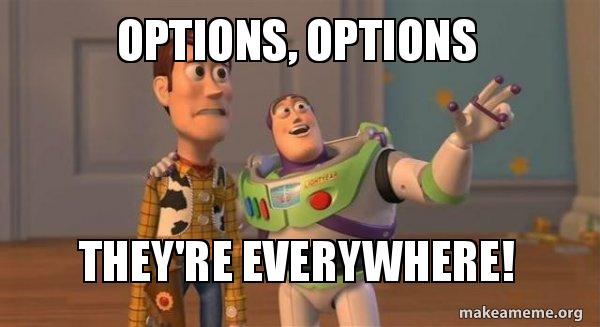I trade options, mostly options on financial indexes such as the S&P 500 and the Nasdaq 100. Option premiums, which is what you pay to buy an option or what you receive if you sell an option, have been declining this year. Said another way, I have to sell at a strike price closer to the trading price of the underlying index in order to generate the same covered call revenue that I was able to generate last year. I believe current options premiums do not represent the full level of risk inherent in our economy, and hence are too low. Read on to see why.

Function of Risk
There are a number of components to the value of an option premium, and among them are Risk, meaning the likelihood that the actual result will differ from the predicted result. When the perceived level of Risk is higher, option premiums will be higher, and vice versa. One measure of Risk in the investing markets is the VIX Index, which I have written about before. The VIX is currently at 16.64, which is very close to its low since the start of Covid during 1Q 2020. It is higher than the 13-ish handle it displayed during most of 2019, by about 28%. One might conclude that the VIX has mirrored Covid infections: a spike during early 2020 followed by a decline to current lower levels, with several bumps along the way. However, I believe this is a simplified reading that misses one key element: government debt.
Increased Debt
Where did the US Government get all of the money it used to pay out to citizens and small businesses as part of the Covid stimulus plan? It borrowed, massively. The US Federal budget deficit in 2020 was $3.1 Trillion, and is projected to be an additional $3 Trillion in 2021. (Source: Congressional Budget Office). That’s $6 + Trillion dollars of additional leverage pumped into our economy. The effect of leverage is that it magnifies any change in the growth or shrinkage of economic performance. If corporate earnings improve, the magnitude of the improvement is enhanced by the leverage, and vice versa.
I ask you: Do you believe an additional $6 Trillion in Federal leverage would tend to enhance or diminish any risks that actual corporate performance matches projected corporate performance? My money says that the leverage would enhance risks, by a significant amount, or much more than the 28% that the VIX is higher now than in 2019. I don’t know by how much, but 28% seems low.
IMO
My argument is not that you should buy VIX Index call options because I believe it will rise; nor is my argument that you should buy Index call options for the same reason. Moreover, I am not arguing the merits of the $6 Trillion expansion of the Federal budget deficit one way or another. My point is that all of this additional borrowing makes projected likely outcomes more risky, and significantly so. If all goes according to script, then no harm and no foul. But when has the economy ever followed a script? As much as a script plays a role, so does improvisation. Consequently, I believe that current option premiums do not fully represent the level of risk commensurate with the higher level of debt in the economy. Perhaps what we will see is a lower base level of the VIX and option premiums, such as we have now, with intermittent spikes to significantly higher levels as incongruent data is released, such that the average over a period of time is heightened. We have a much different economy now than we had before Covid and we should adapt our expectations as a result.
I hope you all are having a good Summer so far, as my family and I are!
